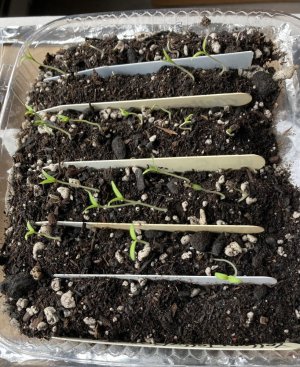digitS'
Garden Master
It surprises me every year.

The first day for the tomato seedlings to venture out to the South Window . There are about 7 seeds of each of these 6 varieties. Two more are in the cookie box with the eggplant. It is the same story there.
. There are about 7 seeds of each of these 6 varieties. Two more are in the cookie box with the eggplant. It is the same story there.
The seedlings of 2 varieties from purchased seed are yet to emerge. The one closest to the camera in the "tomatoes only" box is the purchased seed there – Yellow Jelly Beans hybrid. The other with the eggplant is heirloom, Kellogg's Breakfast. Neither has a single sprout appearing.
Both are a little old – the Kellogg's Breakfast are from 2020; the Jelly Beans are probably from the same year, (that dang Seeds n Such doesn't put dates on their packets). However, the other varieties are also likely from old seed. Every One of those 6 are from Saved Seed and Every One of those has most or all seed sprouted and growing.
I follow a very simple approach to saving tomato and pepper seed. The most serious part of the program is to start seed that is no more than 5 years old. Older and it sprouts but will likely be slower and, starting in these "community containers" means that there is competition for space and sunlight. It is not good if some plants are a week or more behind the others in getting a start.
Anyway, see how competitive the seedsaver (me ) is performing against the seed companies? Surprising to me! Try seed saving if you aren't already
) is performing against the seed companies? Surprising to me! Try seed saving if you aren't already  .
.
Steve

The first day for the tomato seedlings to venture out to the South Window
The seedlings of 2 varieties from purchased seed are yet to emerge. The one closest to the camera in the "tomatoes only" box is the purchased seed there – Yellow Jelly Beans hybrid. The other with the eggplant is heirloom, Kellogg's Breakfast. Neither has a single sprout appearing.
Both are a little old – the Kellogg's Breakfast are from 2020; the Jelly Beans are probably from the same year, (that dang Seeds n Such doesn't put dates on their packets). However, the other varieties are also likely from old seed. Every One of those 6 are from Saved Seed and Every One of those has most or all seed sprouted and growing.
I follow a very simple approach to saving tomato and pepper seed. The most serious part of the program is to start seed that is no more than 5 years old. Older and it sprouts but will likely be slower and, starting in these "community containers" means that there is competition for space and sunlight. It is not good if some plants are a week or more behind the others in getting a start.
Anyway, see how competitive the seedsaver (me
Steve
